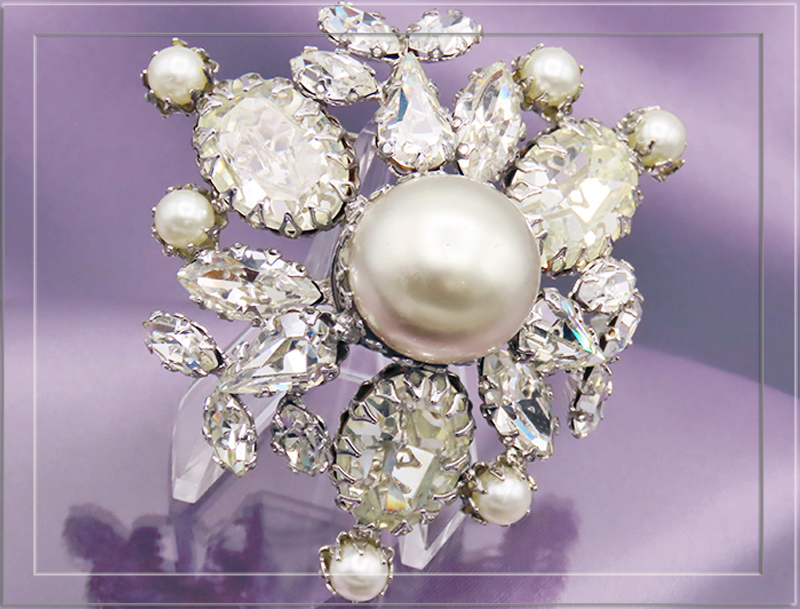Return To Previous Page
Schreiner | Crystal Jewels & Pearl Brooch
Schreiner | Crystal Jewels & Pearl Brooch
. . . . Oh So Elegant!
Schreiner
Although unsigned, the grace and grandeur of Schreiner is always obvious. The pearl centerpiece sits high atop the surrounding crystal jewels creating a crown to be worn with pride. Huge multifaceted oval rhinestones surround the center pearl skirted by a delicious mix of pear and marquise shaped faceted rhinestones. The oval rhinestones have slight yellowing but do not take anything away from the elegance of this piece.
Schreiner has become one of the most treasured among vintage jewelry collectors. It is easy to see why when you are in the presence of this incredible brooch a true Schreiner beauty. ID-
Measurements:
Brooch — Approximately 2 ¾ inches wide by a whopping 1 ⅜ rise.
Schreiner Jewelry History —
Henry Schreiner (1898-1954), a jewelry worker born in Premich, Germany, immigrated to the U.S. in 1923. He opened the Schreiner Jewelry Co. in New York City, in 1932. His daughter Terry and her husband, Ambros Albert, joined the family business in 1951. After Henry died, they continued to produce Schreiner jewelry using the original molds.
The firm prospered in the 1950's-1960's, when their large, elaborate rhinestone jewelry was in style. During those decades, the company produced jeweled buckles, buttons, belts, brooches, necklaces, and earrings for all of the top American fashion houses. Clients included Pauline Trigère, Norman Norelle, Adele Simpson, and Christian Dior. Schreiner jewelry adorned models in many fashion shows as well as photo shoots for Vogue, including the covers of the June 1, 1952, and March 1, 1954, issues. Because of this exposure, the company never advertised.
Most stones came from pre-war Czechoslovakia, then from Germany (where the stones were made by Czech immigrants). Some stones were made especially for Schreiner. Their keystones (kite-shaped crystals that were Schreiner's signature stone) were made by Czechs in post-war Germany. These stones were used in the ruffle pin Terry designed in 1957 and in Maltese crosses.
No trademark was registered for the company. Only pieces made for department stores were stamped "Schreiner" or "Schreiner New York". Jewelry made for the fashion houses was not signed. Even without the maker's mark, many Schreiner pieces can be identified because of their distinctive style, elaborate designs, and high-quality of materials.
Typical characteristics include the following: unfoiled and inverted (i.e., set upside-down) stones, both intended to pick up the color of the material beneath them; large, unusually-shaped crystals; dome-shaped brooches; unconventional yet imaginative color combinations; large triangular prongs; japanned settings; and hook-and-eye construction. Schreiner's pieces were set and finished by hand, so the output was limited. Huge bib necklaces and parures are especially rare.
Having trouble with the small sizes of
yesteryear? Well, most of us do!
The ladies were smaller than the women of today.
NO Problem, be sure to check out our necklace extenders.
The ladies were smaller than the women of today.
NO Problem, be sure to check out our necklace extenders.


